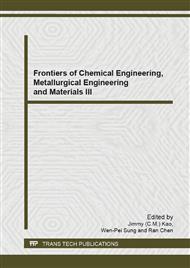p.847
p.851
p.858
p.862
p.868
p.873
p.877
p.882
p.886
Formation Pressure Calculation Based on Modified Flowing Material Balance Method
Abstract:
Formation pressure is an important symbol of driving energy and the key problem of gas reservoir development. Therefore, the formation pressure’s evaluation is a very important work. Due to the invasion of edge-bottom water, using conventional "flow" material balance method to calculate the formation pressure is no longer applicable. According to the theory of reservoir pressure calculation based on flowing material balance method, we established a improved method to calculate the pressure of water drive gas reservoir and verified it by an example. The results show that: edge and bottom water intrusion has obvious effect on the calculation of formation pressure; after considering the influence of water drive, the formation pressure’s calculation results increased, as a consequence the formation pressure’s decreasing range reduced. This research’s result has important reference value for improving the precision of water drive gas reservoir’s formation pressure.
Info:
Periodical:
Pages:
868-872
Citation:
Online since:
August 2014
Authors:
Price:
Сopyright:
© 2014 Trans Tech Publications Ltd. All Rights Reserved
Share:
Citation:


